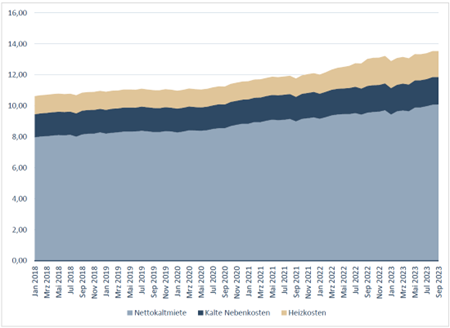Wiesbaden, December 13, 2023 - Additional residential costs continue to make up a high percentage of the total rent, even if the share fell slightly again in 2023 compared to the record value of the previous year. While the nationwide average was a record 27 percent last year, it will still be 25 percent at the end of 2023. The additional housing costs are around 43 percent above the level of the winter of 2021/2022 before the Ukraine war. These are some of the results of the current “Ancillary Housing Costs Report”. For the fourth year in a row, the German Economic Institute (IW) has prepared a report on the hot and cold additional costs in 400 cities and districts in Germany d.i.i.
The additional living costs consist of warm and cold additional costs. While warm additional costs fell slightly compared to the previous year, cold additional costs continued to rise slightly. The sharp increase in net rents resulted in a slight decrease in the share of additional costs.
In 2023, heating one square meter of living space cost an average of 1.67 euros per month nationwide - a small decrease of 4 percent compared to the 1.74 euros of the previous year. The cold additional costs, including garbage disposal and cleaning work, rose moderately by 3 percent to 1.78 euros per square meter from 1.72 euros in the previous year due to general inflation.
“Socially acceptable energy renovation deserves absolute priority in the public discourse and on the legislature’s agenda. The numbers speak for themselves; there is no relaxation when it comes to additional costs. Concrete strategies are needed from owners and property managers for each individual residential complex. With what measures, at what costs and within what time frame can buildings be made more energy efficient in order to meet the double challenge of climate protection and the lack of affordable living space? Tenants, landlords and the public sector must work hand in hand, then win-win situations are possible despite high construction costs,” says Frank Wojtalewicz, board member of d.i.i. Deutsche Invest Immobilien AG and sponsor of the report.
“The impending abolition of state energy price caps means that many households are also threatened with a sudden increase in additional heating costs at the beginning of 2024. This will be a problem, especially for tenants who cannot conclude a new supply contract themselves. Some landlords sometimes lack the incentive to conclude new and sometimes significantly cheaper contracts in the short term because the costs are usually passed on entirely to the tenants. However, moving to a new apartment is often not an option, especially in metropolitan areas,” adds Prof. Dr. Michael Voigtländer, head of the International Economic Policy, Financial and Real Estate Markets Cluster at the IW.
Fig.1: Average advance payments for additional costs and net rent, sources: Value AG; Institute of German Economy.
Energy-saving renovation as the best protection against high additional costs is only making slow progress
Of the hundreds of thousands of apartment advertisements evaluated by the IW, only a good 36 percent contained information about the energy efficiency class of the property. The proportion of rental apartments with energy efficiency class E or worse has fallen from 38 percent in 2018 to 29 percent in 2023. At the same time, the proportion of apartments with medium efficiency class D remained at 25 percent of the advertised stock. The increasing proportion of rental apartments with a high efficiency class is due to both efficient new buildings and energy-efficient renovation measures in existing buildings.
The differences in the monthly installment payments are sometimes clear. In apartments with the highest energy standard A+, an average of 1.22 euros per square meter is quoted per month. In apartments with the lowest energy efficiency (F and worse), an average of 2.00 euros per square meter is due per month. In the most widespread energy efficiency classes C and D it is at least 1.66 euros and 1.75 euros respectively.
Strong differences in additional housing costs by region
The highest cold ancillary costs were due in Bonn in the third quarter of 2023. The average price quoted there is 2.39 euros per square meter. Of the seven largest cities in Germany, Cologne has the highest cold service costs with an average of 2.18 euros per square meter, just ahead of Frankfurt am Main with 2.15 euros. In rural areas, additional costs are on average significantly lower at around 1.50 euros than in large cities, which is due to the higher personnel costs there, but also to the type of property. Multi-family homes often require more complex maintenance, such as maintaining elevators or maintaining green spaces.
In addition to the city states, cold ancillary costs are particularly high in North Rhine-Westphalia and Hesse due to high property tax rates.
Because of the higher demand-related net rents, the percentage of additional housing costs in the total rent is lower in the south of Germany as well as in large cities and metropolitan areas than in other parts of the country.
The average heating costs in all 400 districts were 1.51 euros per square meter of living space per month. The advance payments ranged from 2.25 euros in Heidenheim to 1.00 euros in Cochem-Zell. In a comparison of the seven largest German cities, the highest advance payments for warm additional costs are registered in Munich at 1.91 euros and significantly less in Düsseldorf (1.41 euros) and Cologne (1.59 euros).
The complete additional housing costs report can be found on the website of the German Economic Institute: https://www.iwkoeln.de/wohnnebenkosten

